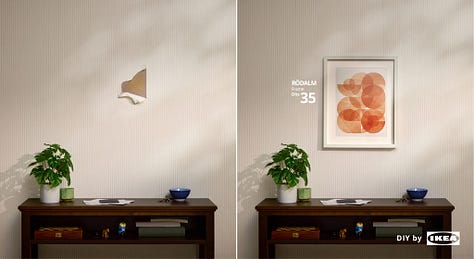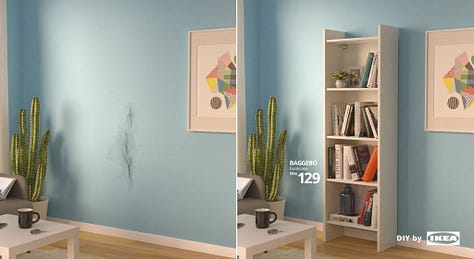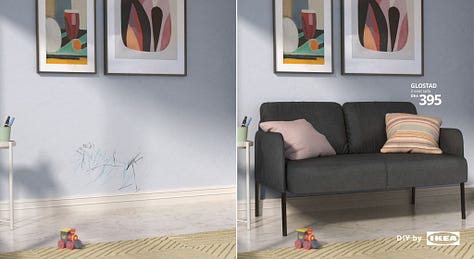IKEA and LEGO aren’t selling products. They’re selling peace of mind.
Empathy: the real brand differentiator.
Not every campaign needs to be clever. But the ones that hit hardest usually are — clever not in concept, but in empathy.
This edition of Two Takes looks at two legacy brands doing something refreshingly modern: acknowledging real life and designing around it. IKEA offers quiet, smart fixes for the chaos that comes with living in one. LEGO makes the case for presence, flow and adult-scale peace of mind.
Neither brand is chasing trends. They’re just paying attention — and creating from that place.
Relatability isn’t a trend. It’s a strategy. And it’s working.



1. Drawings on the Wall, a Masterclass in Restraint
The concept is as simple as it gets: everyday household messes — think holes in the wall, crayon attacks, questionable drywall damage — transformed with IKEA products in a way that feels effortless. A $35 frame becomes a fix. A bookcase covers a hole. The problem doesn’t disappear, but it becomes... livable. Even a little beautiful.
This is IKEA doing what it does best: understanding who they're designing for. Young families. Busy professionals. People who aren’t trying to win Pinterest… but wouldn’t mind feeling like they’ve got it together for five minutes.
What’s more impressive is the restraint. No copy. No tagline. No call to action. Just a visual truth that lands in a second. IKEA could have told us these fixes were clever. Instead, they let us feel it.
Our Takeaway: Good marketing doesn’t need to perform. It just needs to understand you. The result? Trust that lasts longer than the ad.
2. Building Better Days, One Brick at a Time
LEGO’s “Find Your Flow” campaign focuses on a universal feeling: stress.
This campaign is aimed squarely at adults — overworked professionals, stretched-thin parents, and people stuck in the push-pull of modern life. The ad invites you to slow down. Build with intention. Tap into something tactile and steady.
It’s smart. And more importantly, it’s honest.
The message isn’t “go play.” It’s “slow down.” Which makes the product feel less like a toy and more like a tool — a mental reset you can hold in your hands.
The ad follows a woman at the end of a long day — subway chaos, a rude biker, an annoying boss. As she starts to build a delicate set of LEGO flowers, those stressors begin to transform. The bickering kids, the mocking biker, even her manager — each scenario has something that turns into a LEGO object that then breaks into pieces. It’s not aggressive. It’s not dramatic. It’s just satisfying. By the time she finishes her build (cat by her side) the day feels lighter.
In a category that often sells escape, LEGO is selling presence. It’s a subtle but powerful reframing that gives adults permission to prioritize themselves.
Which, when you think about it, is exactly what the product always promised. Just now, the promise is for grownups, too.
Our Takeaway: Relevance doesn’t mean being louder. It means being truer. LEGO’s campaign meets people where they are — and helps them take a breath, one brick at a time.
If there’s a thread here, it’s this: quiet campaigns can still hit hard. Because when a brand shows it understands you — your mess, your mind, your everyday reality — that’s what earns trust and loyalty.
If you’re seeing brand moments out in the wild that have you thinking, hit reply. We’re always up for a good take.
Until next time,
Tandem Creativ ✌🏽




